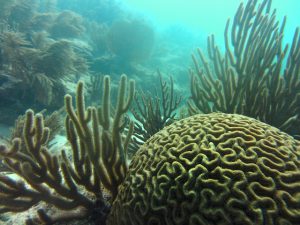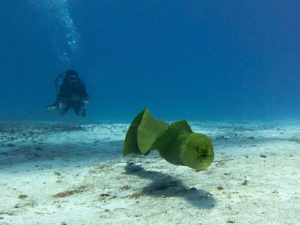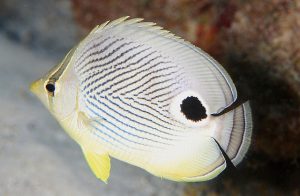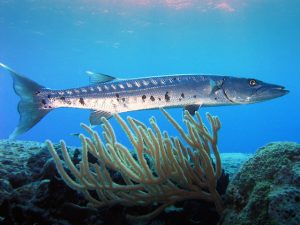The island of Mauritius, located 2000 km off the African coast, is known for its stunning lagoons, white sandy beaches and unique culture and cuisine. But underneath its calm waters is an amazing underwater world filled with shipwrecks, coral reefs and a variety of sea life, making it one of the best places in Africa to scuba dive. With excellent visibility, warm water and dive sites ranging from 7 m to 45 m, it is a place for divers of all experience levels. Here is everything you need to know about scuba diving around the island of Mauritius.
Why Scuba Dive in Mauritius?
With caves to check out, wrecks to view and around 100 dive sites to explore, Mauritius is a scuba diver’s dream diving location. Whether you’re wanting to do daily boat dives, shore dives or a live-aboard, you’ll find it all around this island. And with 27 dive centres on the 2040 km² island, you’ll find affordable and competitive prices. You can pay as little as US$30 for a single dive, or $252 for eleven dives (but shop around to get the best price, if this important to you).
The island has 330km of coastline surrounded by coral reef, which protects it from the open ocean. The coral reef protection makes the tropical waters surrounding the island calm, crystal clear, perfect for shore dives and an excellent place for anyone to become a certified scuba diver.
Best Dive Spots
Mauritius is made up of six diving areas that each offer a unique underwater experience. Here is a breakdown of each dive area, the best dive spot in that area, and what makes each stand out.
South Coast

Brain coral in Blue Bay Marine Park, Mauritius (Louiswray/Wikimedia Commons)
Stretching from Mahébourg up to Blue Bay, this area is filled with beautiful underwater canyons, caves and tunnels. Due to high winds and rough seas, dives beyond the barrier reef are restricted, and visibility can often also be bad.
Best dive spot: Blue Bay Marine Park. With visibility up to 50 metres, this 7 to 20 metre dive is perfect for beginner divers. This protected marine park is for those looking for a relaxing dive and wanting to see fish species and amazing coral including brain coral, stag horn coral, and cabbage coral.
South West Coast

Parrot fish in the Japanese Garden, Mauritius (fugm10/Flickr)
Stretching from the north of Black River to the Le Morne peninsula, this underwater area is mainly sandy seabed, but has some stunning rocky outcrops and coral areas. With visibility ranging from 20 to 40 metres and water temperatures between 20 and 30 degrees, divers are in for a pleasant excursion.
Best dive spot: Japanese Garden. So named because it looks like a tiered Japanese garden, the 14 to 28 metre dive site is filled with tropical fish, moray eels, octopus, rays, parrotfish, pipefish, and a large stone fish population, and has excellent visibility.
North Coast

Clown fish on the north coast of Mauritius (Ritiks/Wikimedia Commons)
Made up of various offshore islands, the north coast stretches from Pointe aux Canonniers to Grand Gaube.
Best dive spot: The Silver Star Wreck. One of the most popular dive sites, this 22 to 39 metre dive lets you view an upright wreck which sank in the early 1990s and is now home to barracuda, scorpion fish and angel fish.
North West Coast

Giant moray eel at Holt’s Rocks in Mauritius (P.Lindgren/Wikimedia Commons)
Starting at Pointe aux Piments and stretching to Pointe aux Canonniers, you can dive here all year round.
Best dive spots:
Holt’s Rocks. Made up of huge boulders surrounded by coral, caves and tunnels, this 18 to 21 metre dive site is home to two-metre-long giant moray eels.
Lost Anchor: Head down 22 to 30 metres and you’ll find two sunken anchors. The first anchor is sitting on sand, while the other is on a small patch of reef.
West Coast

Butterfly fish on the west coast of Mauritius (LASZLO ILYES/Wikimedia Commons)
With most of the diving in this area just outside of the barrier reef, divers can experience drop-offs, caves, caverns and archways in this underwater seascape. With visibility ranging from 20 to 30 metres it is a great place to do day dives, but at night the area becomes magical as polyps open, and the corals changes its colour.
Best dive spot: Kei Sei 113. Head down to 40 metres to explore the converted barge that was sunk in 1988 to form an artificial reef. There is plenty of sea life that now calls it home including red snapper, hawkfish and giant moray eels.
East Coast

Barracuda at Bella Mare, Mauritius (Wikimedia Commons)
Stretching from Grand Gaube to Mahébourg, this area is known for high winds and rough seas so divers need to careful and go with an instructor that knows the area. This area is less populated with tourists and has colder waters than rest of the island.
Best dive spot: Bella Mare. This lagoon has a dive site of around 12 to 30 metres and you can spot a variety of sharks, rays, tuna and barracuda. Divers need to be extra cautious of strong currents in this area.
Practical considerations
Best time of year to dive: Even though Mauritius has great diving all year round, to get the best visibility, water temperature and overall underwater experience, visit the island from October to December and March to April.
Water temperature: Like most tropical destinations, Mauritius has amazing warm water. During the summer months (November to April) temperatures rise to around 30 degrees, while in the winter months (March to October) it can drop as low as 21 degrees.
Gear: Forget the booties, gloves and 8mm wetsuits — all you’ll need to scuba dive in Mauritius is a 3mm wetsuit, a BCD, weight belt and tank. All gear can be rented from one of the 27 dive companies on the island.
Getting certified: Mauritius prides itself on all its dive centres being managed by CMAS or PADI international diving instructors, where beginners can take a course, or experienced divers can upgrade their certification. Dive centres like Coral Diving and Just Diving offer certifications on all levels. Easy Dive Diving Centre is another great option if you are visiting Mauritius as it is a PADI 5 star scuba diving resort.
